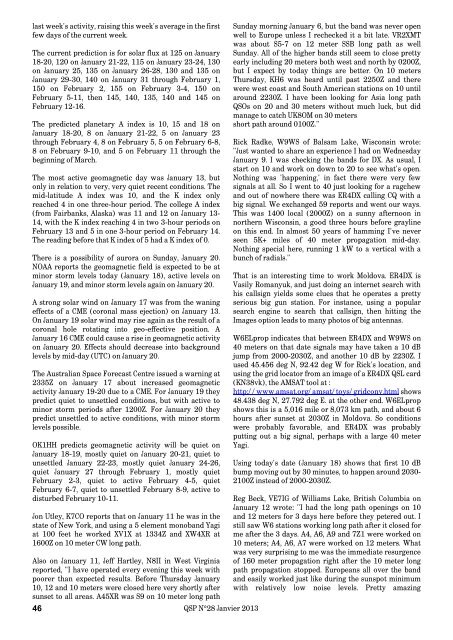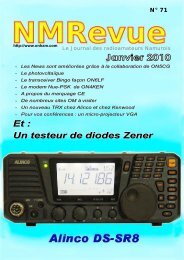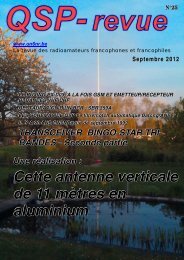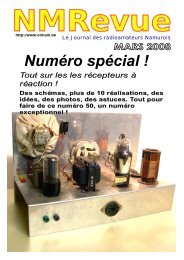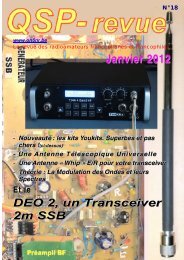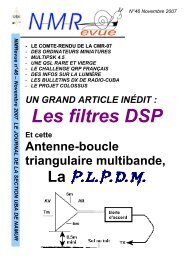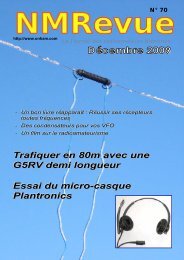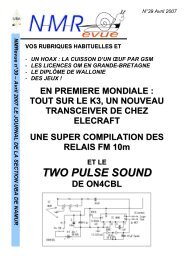Janvier 2013
Janvier 2013
Janvier 2013
- No tags were found...
You also want an ePaper? Increase the reach of your titles
YUMPU automatically turns print PDFs into web optimized ePapers that Google loves.
last week's activity, raising this week's average in the firstfew days of the current week.The current prediction is for solar flux at 125 on January18-20, 120 on January 21-22, 115 on January 23-24, 130on January 25, 135 on January 26-28, 130 and 135 onJanuary 29-30, 140 on January 31 through February 1,150 on February 2, 155 on February 3-4, 150 onFebruary 5-11, then 145, 140, 135, 140 and 145 onFebruary 12-16.The predicted planetary A index is 10, 15 and 18 onJanuary 18-20, 8 on January 21-22, 5 on January 23through February 4, 8 on February 5, 5 on February 6-8,8 on February 9-10, and 5 on February 11 through thebeginning of March.The most active geomagnetic day was January 13, butonly in relation to very, very quiet recent conditions. Themid-latitude A index was 10, and the K index onlyreached 4 in one three-hour period. The college A index(from Fairbanks, Alaska) was 11 and 12 on January 13-14, with the K index reaching 4 in two 3-hour periods onFebruary 13 and 5 in one 3-hour period on February 14.The reading before that K index of 5 had a K index of 0.There is a possibility of aurora on Sunday, January 20.NOAA reports the geomagnetic field is expected to be atminor storm levels today (January 18), active levels onJanuary 19, and minor storm levels again on January 20.A strong solar wind on January 17 was from the waningeffects of a CME (coronal mass ejection) on January 13.On January 19 solar wind may rise again as the result of acoronal hole rotating into geo-effective position. AJanuary 16 CME could cause a rise in geomagnetic activityon January 20. Effects should decrease into backgroundlevels by mid-day (UTC) on January 20.The Australian Space Forecast Centre issued a warning at2335Z on January 17 about increased geomagneticactivity January 19-20 due to a CME. For January 19 theypredict quiet to unsettled conditions, but with active tominor storm periods after 1200Z. For January 20 theypredict unsettled to active conditions, with minor stormlevels possible.OK1HH predicts geomagnetic activity will be quiet onJanuary 18-19, mostly quiet on January 20-21, quiet tounsettled January 22-23, mostly quiet January 24-26,quiet January 27 through February 1, mostly quietFebruary 2-3, quiet to active February 4-5, quietFebruary 6-7, quiet to unsettled February 8-9, active todisturbed February 10-11.Jon Utley, K7CO reports that on January 11 he was in thestate of New York, and using a 5 element monoband Yagiat 100 feet he worked XV1X at 1334Z and XW4XR at1600Z on 10 meter CW long path.Also on January 11, Jeff Hartley, N8II in West Virginiareported, "I have operated every evening this week withpoorer than expected results. Before Thursday January10, 12 and 10 meters were closed here very shortly aftersunset to all areas. A45XR was S9 on 10 meter long path46QSP N°28 <strong>Janvier</strong> <strong>2013</strong>Sunday morning January 6, but the band was never openwell to Europe unless I rechecked it a bit late. VR2XMTwas about S5-7 on 12 meter SSB long path as wellSunday. All of the higher bands still seem to close prettyearly including 20 meters both west and north by 0200Z,but I expect by today things are better. On 10 metersThursday, KH6 was heard until past 2250Z and therewere west coast and South American stations on 10 untilaround 2230Z. I have been looking for Asia long pathQSOs on 20 and 30 meters without much luck, but didmanage to catch UK8OM on 30 metersshort path around 0100Z."Rick Radke, W9WS of Balsam Lake, Wisconsin wrote:"Just wanted to share an experience I had on WednesdayJanuary 9. I was checking the bands for DX. As usual, Istart on 10 and work on down to 20 to see what's open.Nothing was 'happening,' in fact there were very fewsignals at all. So I went to 40 just looking for a ragchewand out of nowhere there was ER4DX calling CQ with abig signal. We exchanged 59 reports and went our ways.This was 1400 local (2000Z) on a sunny afternoon innorthern Wisconsin, a good three hours before graylineon this end. In almost 50 years of hamming I've neverseen 5K+ miles of 40 meter propagation mid-day.Nothing special here, running 1 kW to a vertical with abunch of radials."That is an interesting time to work Moldova. ER4DX isVasily Romanyuk, and just doing an internet search withhis callsign yields some clues that he operates a prettyserious big gun station. For instance, using a popularsearch engine to search that callsign, then hitting theImages option leads to many photos of big antennas.W6ELprop indicates that between ER4DX and W9WS on40 meters on that date signals may have taken a 10 dBjump from 2000-2030Z, and another 10 dB by 2230Z. Iused 45.456 deg N, 92.42 deg W for Rick's location, andusing the grid locator from an image of a ER4DX QSL card(KN38vk), the AMSAT tool at :http://www.amsat.org/amsat/toys/gridconv.html shows48.438 deg N, 27.792 deg E. at the other end. W6ELpropshows this is a 5,016 mile or 8,073 km path, and about 6hours after sunset at 2030Z in Moldova. So conditionswere probably favorable, and ER4DX was probablyputting out a big signal, perhaps with a large 40 meterYagi.Using today's date (January 18) shows that first 10 dBbump moving out by 30 minutes, to happen around 2030-2100Z instead of 2000-2030Z.Reg Beck, VE7IG of Williams Lake, British Columbia onJanuary 12 wrote: "I had the long path openings on 10and 12 meters for 3 days here before they petered out. Istill saw W6 stations working long path after it closed forme after the 3 days. A4, A6, A9 and 7Z1 were worked on10 meters; A4, A6, A7 were worked on 12 meters. Whatwas very surprising to me was the immediate resurgenceof 160 meter propagation right after the 10 meter longpath propagation stopped. Europeans all over the bandand easily worked just like during the sunspot minimumwith relatively low noise levels. Pretty amazing


